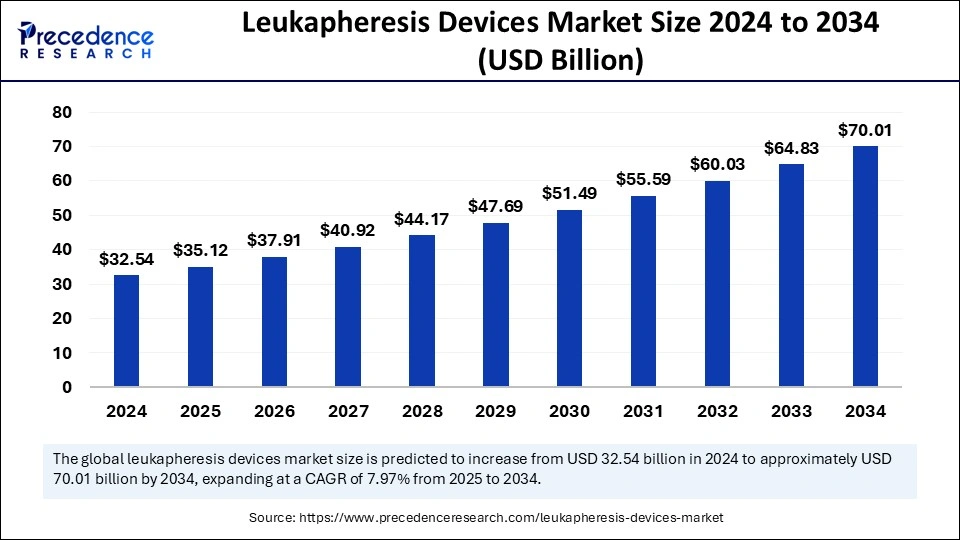 Leukapheresis Devices Key Takeaways
Leukapheresis Devices Key Takeaways- North America dominated the global market with the largest market share of 39% in 2024.
- Asia Pacific is expected to grow at the fastest CAGR over the period studied.
- By device type, the apheresis devices segment dominated the market in 2024.
- By device type, the leukapheresis columns and cell separators segment is expected to grow at the fastest CAGR over the forecast period.
- By application, the research application segment held the largest market share in 2024.
- By application, the therapeutic applications segment is anticipated to grow at the fastest CAGR over the forecast period.
- By end user, The hospital segment dominated the market by holding the largest market share in 2024.
- By end user, the academic and research institutes segment is estimated to grow at the fastest CAGR during the projected period.
Leukapheresis Devices Market Overview
The leukapheresis devices market is experiencing significant growth due to the rising demand for advanced blood separation technologies, especially in therapeutic and research settings. Leukapheresis is a procedure that separates white blood cells from a blood sample, playing a crucial role in the treatment of various hematologic conditions and in cell-based therapies.
The leukapheresis devices market has benefited from the growing adoption of immunotherapy, CAR-T cell therapies, and other advanced medical treatments that require high-purity leukocyte collection. As a result, healthcare providers and research organizations are increasingly investing in efficient, automated leukapheresis systems.
Drivers
A key driver for the leukapheresis devices market is the rising prevalence of cancer and autoimmune disorders, which has created an increased need for targeted treatment approaches such as cellular immunotherapy. The surge in clinical trials for cancer immunotherapies and regenerative medicine is further boosting the demand for high-performance leukapheresis devices.
In addition, technological advancements in blood collection systems, such as improved separation accuracy, portability, and automation, are enhancing the appeal of these devices. Government funding and private investment into stem cell and gene therapy research also contribute to the expansion of the leukapheresis devices market.
Opportunities
The leukapheresis devices market presents numerous opportunities for growth, particularly in emerging economies where healthcare infrastructure is rapidly improving. There is significant potential for market penetration in regions with large patient populations and increasing access to advanced medical care.
Opportunities also exist in the customization of leukapheresis devices for pediatric or geriatric use, as well as in developing more compact, cost-effective systems that can be deployed in outpatient settings. As precision medicine continues to evolve, manufacturers can capitalize on the demand for personalized therapy solutions supported by efficient leukapheresis procedures.
Challenges
Despite its promise, the leukapheresis devices market faces several challenges. One of the primary obstacles is the high cost of devices and procedures, which limits their adoption in lower-income regions and smaller healthcare facilities. Additionally, the complex nature of leukapheresis procedures demands skilled technicians and clinicians, contributing to higher operational costs.
Regulatory requirements for blood component processing and handling can also delay product approvals and limit market expansion. Furthermore, competition from alternative blood separation technologies poses a potential threat to the growth of the leukapheresis devices market.
Regional Insights
North America dominates the leukapheresis devices market, primarily due to its advanced healthcare infrastructure, strong research base, and widespread adoption of novel therapies. The United States, in particular, is a major contributor owing to high clinical trial activity and robust investment in oncology research. Europe follows closely, with countries like Germany and the UK actively engaging in stem cell research and immunotherapy.
The Asia-Pacific region is expected to register the fastest growth in the leukapheresis devices market, supported by increasing healthcare spending, expansion of private hospitals, and rising awareness of advanced treatment options in countries like China and India.
Recent Developments
Recent developments in the leukapheresis devices market include the launch of automated and closed-loop systems that enhance safety and efficiency. Leading companies are focusing on developing portable leukapheresis machines for use in decentralized healthcare settings. Collaborations between medical device firms and biotech companies working on CAR-T and T-cell therapies are further shaping the market landscape.
Additionally, ongoing efforts to reduce procedure times and improve patient comfort have resulted in the integration of user-friendly interfaces and real-time monitoring features in new devices, driving innovation across the leukapheresis devices market.
Leukapheresis Devices Market Companies
- Terumo BCT
- Fresenius SE and Co. KGaA
- Haemonetics Corporation
- Asahi Kasei Corporation
- Macopharma SA
- Miltenyi Biotec
- Medical Spa
- Puriblood Medical Co. Ltd.
- Beijing ZKSK Technology Co. Ltd.
- SB-Kawasumi Laboratories, Inc.
- Nikkiso Co., Ltd.
- Charles River Laboratories International, Inc.
- Discovery Life Sciences, Inc.
- Precision for Medicine, Inc.
Segments Covered in the Report
By Device Type
- Therapeutic Leukapheresis
- Cytapheresis
- Stem Cell Collection
- Research Applications
- Leukapheresis Columns and Cell Separators
- Leukapheresis Disposables
- Apheresis Devices
By Application
- Research Application
- Therapeutic Application
By End User
- Hospitals
- Blood Centers
- Academic and Research Institutes
By Region
- North America
- Europe
- Asia-Pacific
- Latin America
- Middle East and Africa
